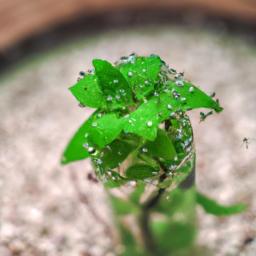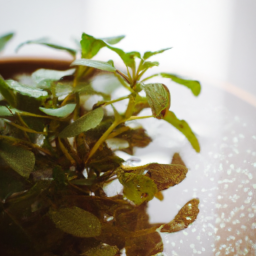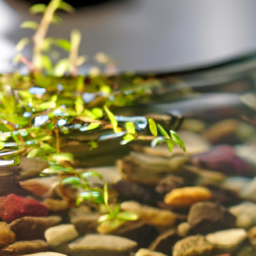
Are you looking to add some greenery to your indoor space but don’t have a green thumb? Well, you’re in luck! Indoor plants can grow in water, making it a hassle-free and low-maintenance option for all plant enthusiasts. Whether you have limited space, limited time, or simply want to try something new, growing indoor plants in water is a fantastic solution. In this blog post, we will explore the wonderful world of hydroponics and discover the benefits, techniques, and best plants to grow without soil. So, let’s dive in and learn how you can create a thriving indoor garden using only water!
Benefits of Growing Indoor Plants in Water
Indoor plants not only enhance the aesthetics of our living spaces but also provide numerous benefits for our overall well-being. While traditional soil-based gardening is widely practiced, growing indoor plants in water has gained popularity in recent years. This method, known as hydroponics, offers several advantages that make it an appealing option for plant enthusiasts. In this article, we will explore the benefits of growing indoor plants in water and provide you with a step-by-step guide to get started.
Improved Air Quality
One of the significant advantages of growing indoor plants in water is their ability to purify the air we breathe. Plants naturally absorb carbon dioxide and release oxygen through the process of photosynthesis. This helps to improve the air quality in our homes by reducing the levels of harmful pollutants and toxins. Studies have shown that indoor plants can effectively remove common indoor air pollutants such as formaldehyde, benzene, and trichloroethylene. By incorporating water-based plants into your indoor space, you can create a healthier environment for you and your loved ones.
Additionally, indoor plants act as natural humidifiers when grown in water. As they release moisture through transpiration, they help to increase the humidity levels in the room. This can be particularly beneficial during dry seasons or in areas with low humidity, as it helps to alleviate dry skin, respiratory issues, and static electricity.
Furthermore, the presence of indoor plants in water can reduce the occurrence of “sick building syndrome.” This condition refers to a range of symptoms experienced by individuals who spend long periods in buildings with poor indoor air quality. By introducing water-based plants, you can mitigate the effects of sick building syndrome and create a healthier and more comfortable living or working environment.
Low Maintenance
Growing indoor plants in water offers the advantage of low maintenance compared to traditional soil-based gardening. Water-based plants eliminate the need for regular watering, as they draw moisture and nutrients directly from the water. This can be especially convenient for individuals with busy schedules or those who struggle with remembering to water their plants.
Moreover, water-based plants require less frequent fertilization. Nutrients can be easily provided to the plants by adding appropriate hydroponic solutions to the water. This eliminates the need for complex fertilizing schedules and reduces the risk of over or under-fertilization, which can be detrimental to plant health.
The absence of soil also minimizes the risk of pests and diseases that commonly affect traditional potted plants. Soil-borne pests such as fungus gnats or root rot are less likely to occur when growing plants in water. This makes water-based gardening an attractive option for those who want to avoid the hassle of dealing with pests and diseases.
Enhanced Growth and Aesthetic Appeal
Indoor plants grown in water often exhibit enhanced growth and vitality compared to their soil-based counterparts. The direct access to water and nutrients allows the plants to focus their energy on growth and development rather than searching for nutrients in the soil. This can result in faster growth rates, larger foliage, and more abundant blooms.
Additionally, water-based plants can be visually appealing and add a unique touch to your indoor decor. The transparent containers used for hydroponics allow you to observe the intricate root systems of the plants, which can be fascinating and aesthetically pleasing. You can choose from a wide variety of indoor plants that thrive in water, ranging from leafy greens like pothos and philodendrons to flowering plants like peace lilies and begonias. The versatility and beauty of water-based plants make them an excellent choice for enhancing the ambiance of any indoor space.
In conclusion, growing indoor plants in water offers numerous benefits, including improved air quality, low maintenance requirements, and enhanced growth. Whether you are a seasoned plant enthusiast or a beginner, hydroponics provides a unique and rewarding way to cultivate a thriving indoor garden. By incorporating water-based plants into your living or working space, you can create a healthier environment while enjoying the beauty and tranquility that indoor plants bring.

Popular Indoor Plants That Can Thrive in Water
Indoor plants not only add beauty and freshness to our living spaces but also have numerous health benefits. While most plants are traditionally grown in soil, there is a growing trend of growing indoor plants in water. This method, known as hydroponics, eliminates the need for soil and allows plants to thrive solely on water and nutrients. If you’re interested in trying out this unique and low-maintenance approach, here are some popular indoor plants that can thrive in water:
1. Pothos (Epipremnum aureum)
Pothos, also known as Devil’s Ivy, is a popular choice for indoor gardeners due to its ability to grow in a variety of conditions. This versatile plant can be grown in both soil and water, making it an excellent option for hydroponics. Pothos plants have heart-shaped leaves that come in various shades of green, making them a visually appealing addition to any room.
To grow pothos in water, start by taking a healthy cutting from an existing plant. Trim off any leaves near the bottom of the cutting and place it in a jar or vase filled with water. Make sure the nodes, which are small bumps on the stem where roots can develop, are submerged in the water. Place the container in a well-lit area but away from direct sunlight to prevent leaf burn.
Change the water every two weeks to ensure it stays fresh and free from algae. Pothos plants are relatively low-maintenance and can survive in water for extended periods. However, if you notice the roots becoming overcrowded or the plant showing signs of decline, it may be time to transfer it to soil.
Pothos plants are excellent air purifiers and can remove toxins such as formaldehyde and benzene from the air. They are also known to improve indoor air quality, making them a perfect choice for homes and offices.
2. Chinese Evergreen (Aglaonema)
The Chinese Evergreen is a popular houseplant that is well-suited for growing in water. With its striking foliage and ability to tolerate low light conditions, it’s no wonder why this plant is a favorite among indoor gardeners. Chinese Evergreens come in a variety of colors and patterns, ranging from dark green to silver and even red.
To grow Chinese Evergreen in water, select a healthy stem cutting and place it in a jar or vase filled with water. Make sure at least a few nodes are submerged in the water to encourage root growth. Place the container in a well-lit area, but avoid direct sunlight as it can scorch the leaves.
Chinese Evergreens prefer consistently moist soil, so be sure to change the water every two weeks or whenever it becomes murky. If you notice the roots becoming overcrowded or the plant showing signs of decline, it’s time to transfer it to soil. Use a well-draining potting mix and keep the soil evenly moist.
Chinese Evergreens are known for their air-purifying qualities, as they can filter out harmful toxins like formaldehyde and benzene. They are also relatively low-maintenance, making them an ideal choice for busy individuals or those new to indoor gardening.
3. Lucky Bamboo (Dracaena sanderiana)
Lucky Bamboo is a popular indoor plant that is often associated with good luck and positive energy. Despite its name, Lucky Bamboo is not actually bamboo but belongs to the Dracaena family. It is a versatile plant that can be grown in water or soil, making it a great choice for hydroponics.
To grow Lucky Bamboo in water, start by selecting a healthy stalk with green leaves. Place the stalk in a container filled with water, ensuring that the water level covers at least an inch of the stalk. You can use decorative stones or pebbles to hold the stalk in place and add aesthetic appeal to the arrangement.
Keep the container in a well-lit area, but avoid direct sunlight as it can cause the leaves to burn. Change the water every two weeks to prevent stagnation and maintain the plant’s health. Lucky Bamboo is a slow-growing plant, so you won’t need to worry about repotting it frequently.
Lucky Bamboo is believed to bring good fortune and positive energy into a space. It is often used in Feng Shui practices to enhance the flow of chi and promote harmony. Whether you believe in its luck-bringing abilities or not, Lucky Bamboo is undoubtedly a beautiful and low-maintenance plant to grow in water.
Growing indoor plants in water can be a rewarding and visually appealing way to bring nature into your home or office. By choosing plants like Pothos, Chinese Evergreen, and Lucky Bamboo, you can create stunning hydroponic displays that require minimal effort to maintain. So why not give it a try and experience the joy of watching your indoor plants thrive in water?

How to Care for Indoor Plants Growing in Water
Introduction
Indoor plants can bring life and beauty to any space, and growing them in water is an excellent alternative to traditional soil-based gardening. Not only does it eliminate the mess associated with soil, but it also allows you to witness the fascinating process of roots growing and thriving in water. In this guide, we will explore the essential steps to care for indoor plants growing in water, ensuring their health and longevity.
Choosing the Right Plants
When selecting plants for water-based growth, it is crucial to choose species that are well-suited for this environment. Some popular choices include pothos, philodendron, spider plants, and lucky bamboo. These plants have adapted to thrive in water and can withstand the absence of soil. Additionally, make sure to choose healthy plants with vibrant leaves and strong stems, as they are more likely to adapt successfully to water-based growth.
Once you have chosen your plants, it’s time to prepare the water for their growth. Fill a container with clean, room temperature water, ensuring that it is free from any chemicals or contaminants that could harm the plants. You can use tap water, but it’s recommended to let it sit for 24 hours to allow any chlorine to dissipate. Alternatively, you can use filtered or distilled water for optimal plant health.
Now that you have your plants and water ready, it’s time to move on to the next step.
Planting and Placement
Before you begin planting your indoor plants in water, it’s essential to trim any damaged or unhealthy roots. This will encourage new root growth and prevent any potential diseases from spreading. Gently remove the plant from its nursery pot and rinse off the soil from the roots under running water. Once the roots are clean, place the plant in the container with water, ensuring that the roots are fully submerged.
When it comes to placement, indoor plants growing in water thrive in bright, indirect light. Avoid placing them in direct sunlight, as it can cause excessive heat and damage the plant’s delicate roots. Instead, choose a spot near a window with filtered light or use artificial grow lights to provide the necessary light spectrum for healthy growth. Additionally, make sure the plants are placed away from drafts or extreme temperature fluctuations.
Now that your plants are in their designated spot, let’s move on to the next step to ensure their proper care.
Watering and Nutrient Supply
Unlike traditional soil-based plants, indoor plants growing in water require a different approach to watering. It’s essential to regularly check the water level and ensure it covers the roots adequately. If the water level drops, add more water to maintain the desired level. However, avoid overfilling the container, as it can lead to waterlogging and root rot.
In addition to water, indoor plants growing in water also require nutrients to thrive. You can either use a liquid fertilizer specifically formulated for hydroponic plants or opt for natural alternatives. One popular option is to add a small amount of aquarium water to the container, as it contains beneficial nutrients from fish waste. Another natural option is to use organic compost tea, which can be made by steeping compost in water for a few days. Remember to follow the recommended dosage and application frequency for the chosen nutrient supply.
Regularly monitor the water quality and change it every two to three weeks to prevent the build-up of algae or bacteria. Rinse the roots gently under running water before placing them back in the fresh water. This will ensure optimal nutrient absorption and prevent any potential issues.
Pest Control and Maintenance
Just like traditional potted plants, indoor plants growing in water can be susceptible to pests. Keep a close eye on your plants and regularly inspect them for any signs of pests such as aphids, mealybugs, or spider mites. If you notice any pests, remove them manually or use an organic pest control solution suitable for water-based plants. Additionally, ensure proper ventilation and air circulation around the plants to prevent the development of fungal diseases.
Regular maintenance is key to the long-term health of your indoor plants growing in water. Monitor their growth and remove any yellow or decaying leaves to maintain a clean and healthy environment. If you notice excessive root growth, consider transferring the plant to a larger container with fresh water. This will provide the necessary space and nutrients for continued growth.
Remember to enjoy the process of caring for your indoor plants growing in water. Observing their growth and witnessing the intricate web of roots can be a rewarding and fascinating experience. With proper care and attention, your water-based plants will thrive and bring beauty to your indoor space for years to come.
Crisp Recap
Indoor plants are a great way to bring nature into our homes, but not everyone has a green thumb or the time to tend to their plants. Luckily, there is a simple solution that requires minimal effort and still allows you to enjoy the beauty of indoor plants – growing them in water! Yes, you heard that right. Many common houseplants can thrive and grow without soil, making them perfect for those who struggle with traditional potting methods.
Growing plants in water, also known as hydroponics, has gained popularity in recent years due to its simplicity and the stunning results it can achieve. The process is straightforward: instead of planting your chosen indoor plant in soil, you place it in a container filled with water. The plant’s roots will then absorb the necessary nutrients directly from the water, eliminating the need for soil altogether. This method not only saves you the hassle of dealing with messy soil but also reduces the risk of overwatering or underwatering your plants, as the water acts as a self-regulating system.
Curious Minds Asked, We Responded. Frequently Asked Questions:
Q1: Can indoor plants grow in water?
A1: Yes, many indoor plants can indeed grow in water. These plants are commonly known as hydroponic plants or water-grown plants. They have adapted to survive and thrive without the need for soil by absorbing nutrients directly from the water.
Q2: What are the benefits of growing indoor plants in water?
A2: Growing indoor plants in water offers several benefits. Firstly, it eliminates the need for soil, making it a cleaner and more visually appealing option. Additionally, water-grown plants tend to have fewer pest issues and require less maintenance. They also improve air quality by absorbing toxins and releasing oxygen, creating a healthier environment.
Q3: How do I start growing indoor plants in water?
A3: To start growing indoor plants in water, you’ll need a few essential items. Begin by selecting a suitable plant that can thrive in water, such as pothos, spider plant, or lucky bamboo. Next, choose a container that can hold water without leaking. Fill the container with filtered or distilled water, ensuring it covers the roots of the plant. Finally, place the container in a well-lit area, away from direct sunlight, and regularly change the water to prevent stagnation.
Q4: Do water-grown plants require any special care?
A4: While growing indoor plants in water is relatively low-maintenance, they still require some care. Regularly check the water level to ensure it covers the roots, as plants can suffer if the roots dry out. It’s also important to change the water every few weeks or whenever it becomes cloudy to prevent the growth of algae or bacteria. Lastly, monitor the plant for any signs of nutrient deficiencies and provide appropriate hydroponic plant food if needed.
Q5: Can I transfer a plant from soil to water?
A5: Yes, it is possible to transfer a plant from soil to water. However, not all plants will successfully adapt to this transition. It is best to choose plants that are known to thrive in water or have the ability to grow in both soil and water, such as pothos or philodendron. Before transferring, gently remove the soil from the roots and place the plant in a container with water, ensuring the roots are submerged. Monitor the plant closely during the transition period and provide necessary care to help it adjust to the new environment.

James Wong is a renowned ethnobotanist, plant scientist, and local television presenter. With a passion for demystifying plant science, he is known for translating complex botanical concepts into practical advice for everyday plant enthusiasts. James’s expertise spans from traditional gardening to cutting-edge plant technologies, making his insights accessible and informative.


